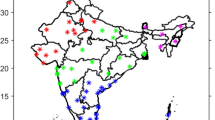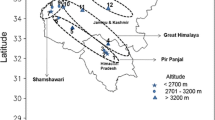Abstract
The tragic events of Sept. 11, 2001 resulted in suspension of commercial flights over North America. It has been suggested that the diurnal temperature range (DTR) increased due to an absence of airplane contrails. This study examined hourly data observed at 288 stations. The average DTR, temperature, maximum/minimum temperature and relative humidity were found for each day in 2001 and compared to the average value occurring during 1975–2005. For the coterminous U.S., the DTR averaged over the period Sept. 11–14, 2001 was about 1°C larger than that found for the 3 days prior and after the flight ban. However, the day-to-day DTR does not correlate well with the flight ban. Plots of the change in DTR throughout North America during Sept. 8–17 show changes consistent with the natural progression of weather systems.





Similar content being viewed by others
References
De Grand JQ, Carleton AM, Travis DJ, Lamb PJ (2000) A satellite-based climatic description of jet aircraft contrails and associations with atmospheric conditions, J. Applied Meteorology 39:1434–1459
Dietmüller S, Ponater M, Sausen R, Hoinka K (2008) Contrails, natural clouds and diurnal temperature range, J. Climate 21:5061–5075
Hong G, Yang P, Hu YX, North G (2008) Do contrails significantly reduce daily temperature range? Geophys Res Lett 35:L23815
Isaac V, van Wijngaarden WA (2011) Surface water vapour pressure and temperature trends in North America during 1948–2010. J Climate, in press
Kalkstein AJ, Balling RC (2004) Impact of unusually clear weather on United States daily temperature range following 9/11/2001. Climate Res 26:1–4
Travis DJ, Carleton AM, Lauritsen RG (2002) Contrails reduce daily temperature range. Nature 418:601
Travis DJ, Carleton AM, Lauritsen RG (2004) Regional variations in US. diurnal temperature range for the 11–14 September 2001 aircraft groundings: evidence of jet contrail influence on climate. J Climate 17:1123–1134
van Wijngaarden WA, Vincent LA (2005) Examination of discontinuities in hourly surface relative humidity in Canada during 1953–2003. J Geophys Res 110:D22102
van Wijngaarden WA (2008) Examination of Canadian climate immediately after Sept. 11, 2001, Proc. American Meteorological Soc. Meeting, New Orleans.
Vincent L, van Wijngaarden WA, Hopkinson R (2007) Surface temperature and humidity trends in Canada for 1953–2005, J. Climate 20:5100–5113
Acknowledgements
The author wishes to thank Environment Canada and J. Comeaux of the University Corporation for Atmospheric Research for access to the station observations and the Natural Sciences and Engineering Research Council for financial support.
Author information
Authors and Affiliations
Corresponding author
Rights and permissions
About this article
Cite this article
van Wijngaarden, W.A. Examination of diurnal temperature range at coterminous U.S. stations during Sept. 8–17, 2001. Theor Appl Climatol 109, 1–5 (2012). https://doi.org/10.1007/s00704-011-0559-9
Received:
Accepted:
Published:
Issue Date:
DOI: https://doi.org/10.1007/s00704-011-0559-9




